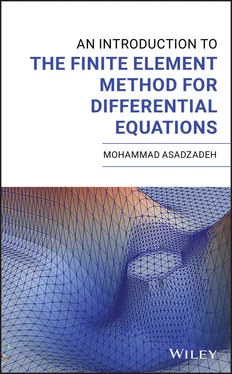Mohammad Asadzadeh - An Introduction to the Finite Element Method for Differential Equations
Здесь есть возможность читать онлайн «Mohammad Asadzadeh - An Introduction to the Finite Element Method for Differential Equations» — ознакомительный отрывок электронной книги совершенно бесплатно, а после прочтения отрывка купить полную версию. В некоторых случаях можно слушать аудио, скачать через торрент в формате fb2 и присутствует краткое содержание. Жанр: unrecognised, на английском языке. Описание произведения, (предисловие) а так же отзывы посетителей доступны на портале библиотеки ЛибКат.
- Название:An Introduction to the Finite Element Method for Differential Equations
- Автор:
- Жанр:
- Год:неизвестен
- ISBN:нет данных
- Рейтинг книги:3 / 5. Голосов: 1
-
Избранное:Добавить в избранное
- Отзывы:
-
Ваша оценка:
An Introduction to the Finite Element Method for Differential Equations: краткое содержание, описание и аннотация
Предлагаем к чтению аннотацию, описание, краткое содержание или предисловие (зависит от того, что написал сам автор книги «An Introduction to the Finite Element Method for Differential Equations»). Если вы не нашли необходимую информацию о книге — напишите в комментариях, мы постараемся отыскать её.
An Introduction to the Finite Element Method (FEM) for Differential Equations
An Introduction to the Finite Element Method

 is a linear equation, while
is a linear equation, while  is a nonlinear equation. The nonlinear equations are often further classified into subclasses according to the type of their nonlinearity. Generally, the nonlinearity is more pronounced when it appears in higher‐order derivatives. For example, the following equations are both nonlinear
is a nonlinear equation. The nonlinear equations are often further classified into subclasses according to the type of their nonlinearity. Generally, the nonlinearity is more pronounced when it appears in higher‐order derivatives. For example, the following equations are both nonlinear

 denotes the norm of the gradient of
denotes the norm of the gradient of  . While ( 1.3.5) is nonlinear, it is still linear as a function of the highest‐order derivative (here
. While ( 1.3.5) is nonlinear, it is still linear as a function of the highest‐order derivative (here  and
and  ). Such a nonlinearity is called quasilinear . On the other hand, in ( 1.3.4), the nonlinearity is only in the unknown solution
). Such a nonlinearity is called quasilinear . On the other hand, in ( 1.3.4), the nonlinearity is only in the unknown solution  . Such equations are called semilinear .
. Such equations are called semilinear . where
where  . We denote by
. We denote by  the operation of a mapping (operator)
the operation of a mapping (operator)  on a function
on a function  .
. that satisfies
that satisfies
 and
and  are functions, is called a linear operator. We may generalize ( 1.4.1) as
are functions, is called a linear operator. We may generalize ( 1.4.1) as
 maps any linear combination of
maps any linear combination of  's to corresponding linear combination of
's to corresponding linear combination of  's.
's. defined on the space of continuous functions on
defined on the space of continuous functions on  defines a linear operator from
defines a linear operator from  into
into  , which satisfies both ( 1.4.1) and ( 1.4.2).
, which satisfies both ( 1.4.1) and ( 1.4.2). that transforms a function
that transforms a function  of the variables
of the variables  into another function
into another function  is given by
is given by
 represents any function in, say
represents any function in, say  , and the dots at the end indicate higher‐order derivatives, but the sums contain only finitely many terms.
, and the dots at the end indicate higher‐order derivatives, but the sums contain only finitely many terms. is given by ( 1.4.3) and
is given by ( 1.4.3) and  , are any set of functions possessing the requisite derivatives, and
, are any set of functions possessing the requisite derivatives, and  are any constants, then relation ( 1.4.2) is fulfilled. This is an immediate consequence of the fact that ( 1.4.1) and ( 1.4.2) are valid for
are any constants, then relation ( 1.4.2) is fulfilled. This is an immediate consequence of the fact that ( 1.4.1) and ( 1.4.2) are valid for  replaced with the derivative of any admissible order. A linear differential equation defines a linear differential operator: the equation can be expressed as
replaced with the derivative of any admissible order. A linear differential equation defines a linear differential operator: the equation can be expressed as  , where
, where  is a linear operator and
is a linear operator and  is a given function. The differential equation of the form
is a given function. The differential equation of the form  is called a homogeneous equation . For example, define the operator
is called a homogeneous equation . For example, define the operator  . Then
. Then










